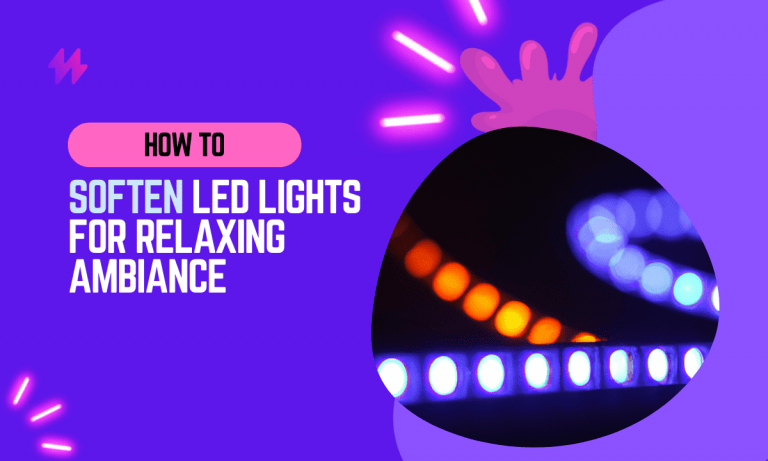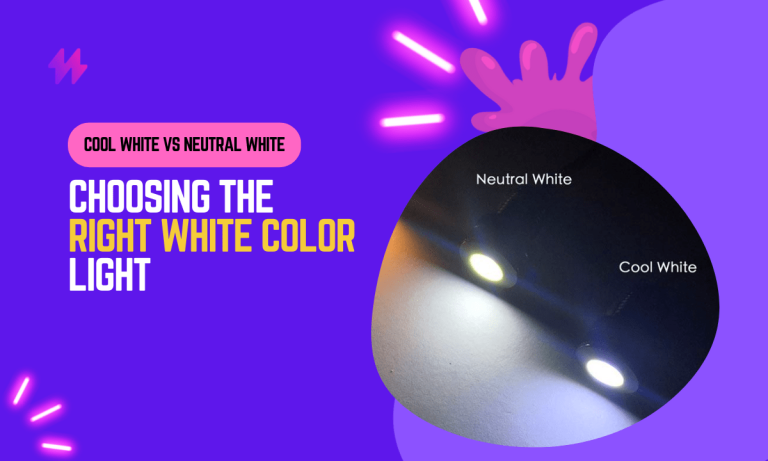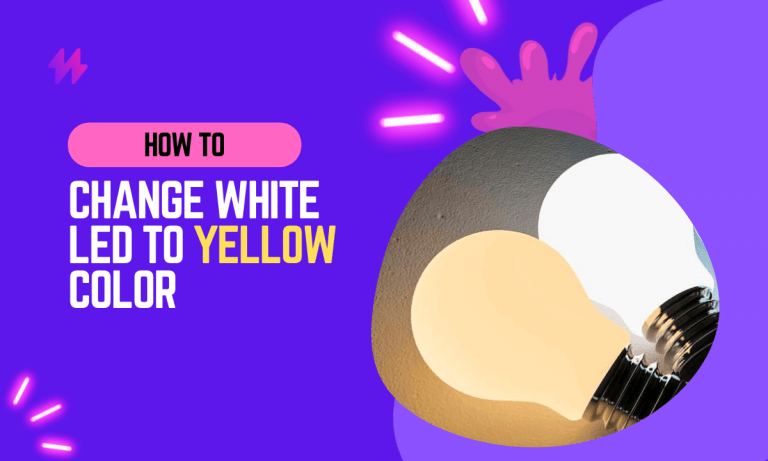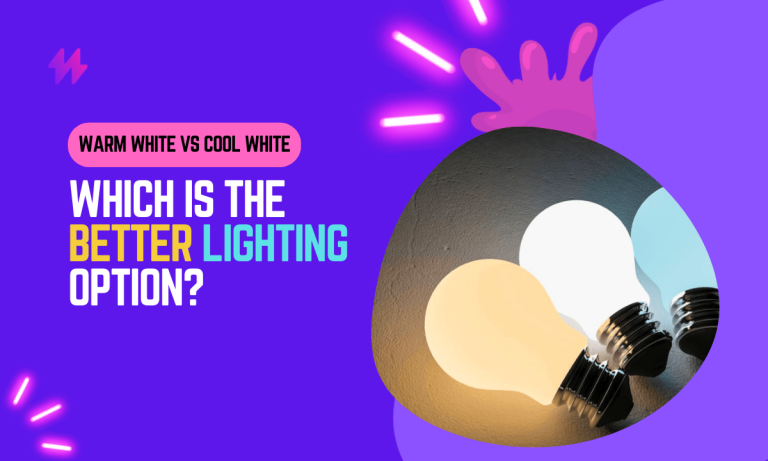3000K vs 4000K Color Temperature Lighting – What’s the Difference
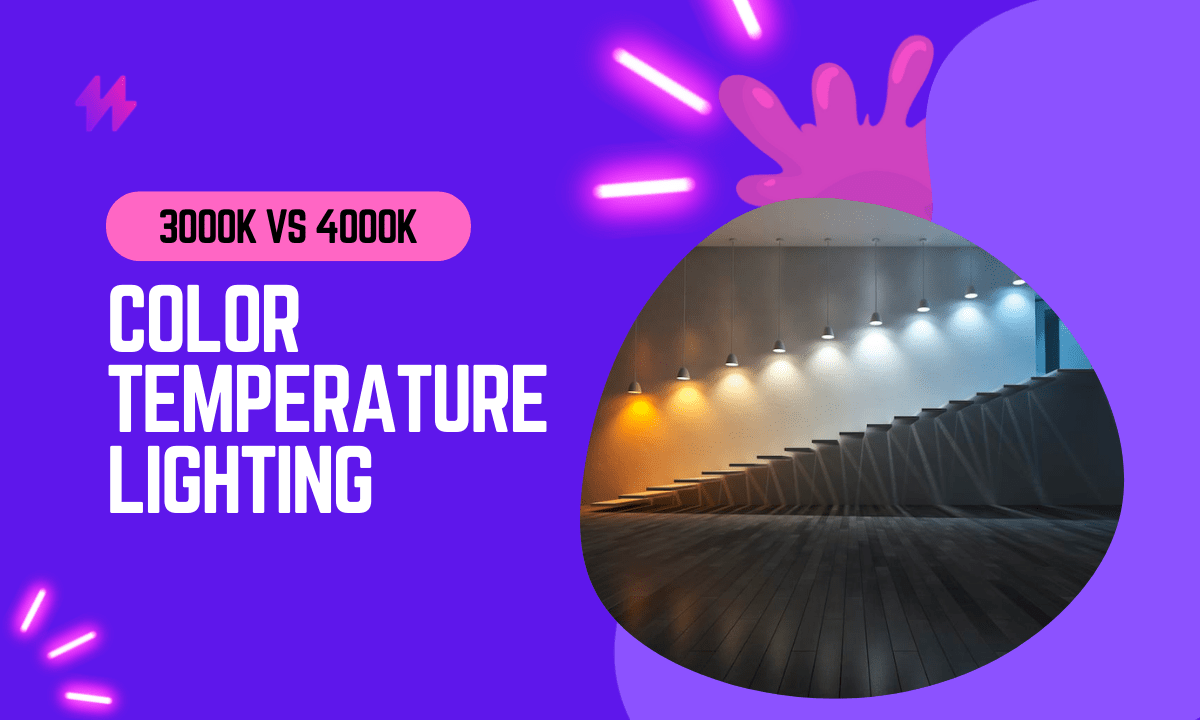
Lighting is an essential element of any space, whether it be a home, office, or retail store. The proper lighting in any place can create a warm and welcoming atmosphere, while the wrong lighting can make a space feel cold and unwelcoming. One common choice that people face when selecting lighting is between bulbs with a color temperature of 3000K and 4000K.
But what exactly is the difference between these two types of lighting, and how do they affect the appearance of a space?
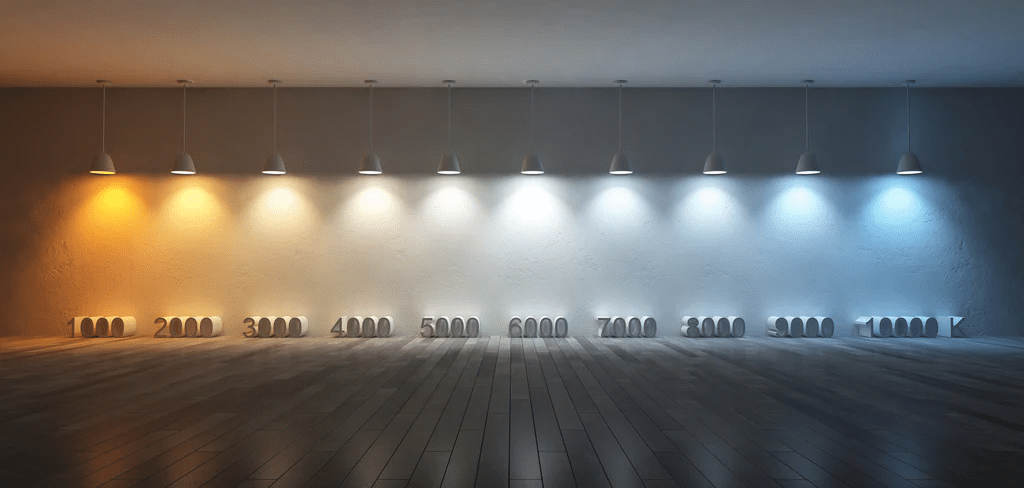
In this blog post, we’ll go through the characteristics of 3000K and 4000K lighting, including their visual differences, energy efficiency, cost, and impact on health and well-being.
By the end of this post, you’ll have a better understanding of the pros and cons of each type of lighting and be able to make an informed decision about which is the best fit for your needs.
Understanding the differences between 3000K and 4000K lighting is crucial for choosing the right light source for your space. While 3000K offers a warm glow reminiscent of traditional incandescent bulbs, 4000K provides a cooler light that can enhance the appearance of certain colors and improve visibility, making it ideal for workspaces or areas requiring brighter lights.
Understanding 3000K vs 4000K Color Temperature Lighting: What’s the Difference?
3000K and 4000K lighting refer to the color temperature of the light produced by a bulb. Color temperature is a measure of the hue of a particular type of light, and it is expressed in degrees Kelvin (K). The higher the color temperature, the cooler and bluer the light appears; conversely, the lower the color temperature, the warmer and more yellow the light appears.
3000K and 4000K lighting play significant roles in defining the atmosphere of a space through their respective warmth and coolness. Selecting the right colour temperature from the kelvin scale can greatly impact the overall lighting application and enhance the desired illumination effect in areas such as workspaces or living rooms. The choice between these two popular color temperatures can influence not only visibility but also contribute to creating an enjoyable lighting experience.
3000K vs 4000K Color Temperature Lighting: What’s the Difference?
3000K lighting is considered to be warm white or soft white lighting, as it has a warm, yellowish hue. This type of lighting is often used to create a cozy, welcoming atmosphere, and is commonly found in residential settings such as living rooms and bedrooms.
3000K lighting is often compared to incandescent lighting due to its warm glow, creating a comforting environment reminiscent of natural sunlight at dusk. When considering lighting for a room, it’s important to understand that the color temperature refers to the hue of the light emitted, significantly influencing the overall ambiance and effectiveness of the lighting solutions in your space.
Understanding 3000K vs 4000K Color Temperature Lighting – What’s the Difference?
On the other hand, 4000K lighting is known as cool white or daylight lighting, as it has a cooler, more blueish hue. This type of lighting is often used to create a bright, vibrant atmosphere, and is commonly found in settings such as offices, retail stores, and hospitals.
It’s important to note that the color temperature of a light bulb is not the same as the brightness of the bulb, which is measured in lumens.
Note: A bulb with a high color temperature can still be dim, and a bulb with a low color temperature can still be bright. However, the color temperature of a light bulb can affect how the brightness appears to the human eye. For example, a 3000K bulb may appear brighter than a 4000K bulb of the same lumen output because the warm white light is more comfortable and easier on the eyes.
Also read: Soft White vs Daylight – What to choose?
For those looking to achieve an ideal balance between ambiance and functionality, understanding 3000K vs 4000K color temperature lighting is vital. By selecting the appropriate lighting temperature, you can create an environment that enhances both comfort and visual clarity, ultimately meeting your specific lighting requirements.
Visual Differences in 3000K vs 4000K Lighting
To give you a better idea of the visual differences between the two types of lighting, let’s look at an example. In the following photos, the left image shows a room illuminated with 3000K lighting, while the right image shows the same room illuminated with 4000K lighting:
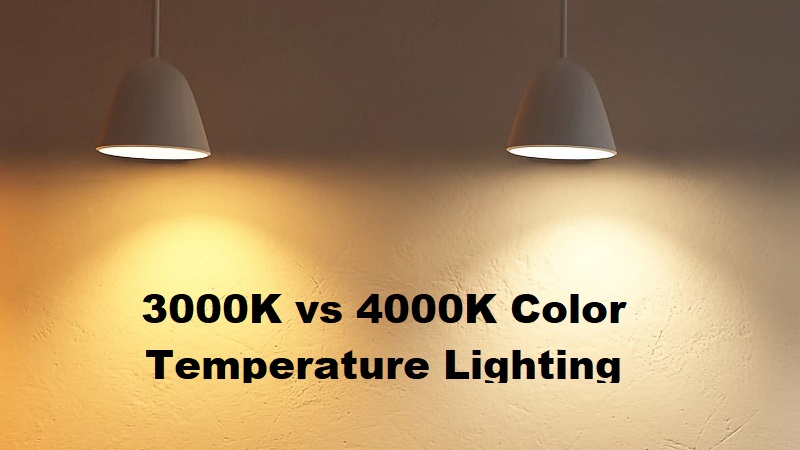
As you can see, the 3000K lighting gives the room a warm, cozy feel, while the 4000K lighting gives the room a brighter, more vibrant feel. The color temperature of the lighting can significantly impact the overall appearance of a space and the way that objects and surfaces look.
It’s worth noting that the visual differences between 3000K and 4000K lighting can also depend on the context and the specific colors in the room. For example, a room with cool-toned colors (such as blues and greens) may look better with 4000K lighting, while a room with warm-toned colors (such as reds and yellows) may look better with 3000K lighting. It’s always a good idea to experiment with different types of lighting to see what works best in your space.
Also check out: Difference between 3000K vs 2700K lighting
The impact of light temperature on a room’s ambiance can transform the way colors are perceived, especially when using LED lighting or light bulbs with varying temperatures. Understanding the distinction between warm and cool colors in the 3000K vs 4000K color temperature lighting allows you to tailor your lighting to enhance specific color schemes and create the ideal atmosphere for any occasion.
Exploring 3000K vs 4000K: Energy Efficiency and Cost Insights
When choosing between 3000K and 4000K lighting, it’s important to consider not only the visual appearance of the light but also its energy efficiency and cost.
In terms of energy efficiency, both 3000K and 4000K lighting can be energy-efficient if they are labeled as such and use energy-saving technologies such as LED. However, it’s worth noting that some research has suggested that 4000K lighting may be slightly more energy-efficient than 3000K lighting.
In terms of cost, the price of 3000K and 4000K lighting can vary depending on the brand, technology (e.g., LED vs. incandescent), and other factors. In general, LED bulbs tend to be more energy-efficient and cost-effective in the long run than incandescent bulbs, but they may have a higher upfront cost. It’s a good idea to compare the costs of different bulbs and consider the long-term cost-savings of more energy-efficient options.
When considering your lighting options, think about how different **colour temperatures** can affect your overall space. The **3000K vs 4000K color temperature lighting – what’s the difference** can significantly influence your room’s atmosphere, whether you prefer the warm glow of **incandescent lights** or the crispness of **LED strip lights**.
Exploring the Differences in Health and Well-being: 4000K vs 3000K Lighting
In addition to their visual appearance and energy efficiency, the color temperature of lighting can also have an impact on health and well-being. Here are a few factors to consider:
In addition to their visual appearance and energy efficiency, the color temperature of lighting can also have an impact on health and well-being. Light color greatly influences mood and productivity; thus, understanding the **colour temperature difference** between **3000K** and **4000K** can help you optimize your **entire lighting setup** for various activities, from energetic light for work to a warm glow for relaxation. Selecting the **right lighting** according to specific tasks, such as using **task lighting** at **4000K** for high visibility, can enhance both functionality and comfort in a space.
- Eye strain: Some research has suggested that 4000K lighting may cause less eye strain than 3000K lighting, as it appears brighter and more vibrant to the human eye. However, it’s worth noting that other factors such as the brightness of the lighting and the duration of exposure can also cause eye strain.
- Sleep patterns: The color temperature of lighting can also affect sleep patterns. Some research has suggested that exposure to blue-enriched light (such as that produced by 4000K lighting) in the evening can suppress the production of the hormone melatonin, which can make it harder to fall asleep. On the other hand, exposure to warmer light (such as that produced by 3000K lighting) in the evening can help to promote the production of melatonin and improve sleep quality.
- Mood: The color temperature of lighting can also impact mood. Some research has suggested that exposure to warm white light (such as that produced by 3000K lighting) can improve mood and reduce stress, while exposure to cool white light (such as that produced by 4000K lighting) can have a more stimulating effect.
Choosing the Right Moment for 3000K (Warm White) LED Lighting
If you’re looking to create a warm and inviting atmosphere, LED light is a great choice. 3000K LED light, in particular, emits a soft, soothing glow.
This color temperature is often used in living rooms. It can create a cozy and inviting atmosphere.
Many people also use this color temperature in their bedrooms. It can help you relax and feel more at ease in your space. Bathrooms are another common space to find this color temperature. It can help soften the overall look of the room.
Whether adding ambiance to your living room or trying to create a relaxed dining experience, 3000K LED light can help you set the perfect tone.
To further enhance your space, consider the benefits of **smart lighting** that allows you to adjust brightness and color temperature according to your needs. Choosing between **3000K and 4000K color temperature** lights can dramatically influence the aesthetics of your **lighting setup**, enabling you to achieve the perfect **ambient lighting** for any setting.
Choosing the Right Moment for 4000K (Cool White) LED Light
Areas that require a more clinical feel can be perfectly illuminated with a 4000K LED light. This light emits a clean, bright white color that creates an inviting atmosphere.
4000k color temperature is often used in kitchens, office spaces, and hospitals because it promotes concentration and energy. In fact, studies have shown that people who work in rooms with this type of lighting tend to be more productive. This makes it a popular choice for many businesses and institutions.
Choosing the right color temperature is essential for establishing the desired ambiance in any space. For instance, while **3000K** can create a warm and welcoming atmosphere akin to **sunset**, **4000K color temperature is higher than the color temperature 3000K**, offering a more vibrant and energetic setting suitable for **general lighting** in work environments.
Final Thoughts on 3000K vs 4000K Lighting Choices
When comparing 3000K and 4000K color temperatures in lighting, the distinctions not only impact the aesthetics of a space but also influence its functionality and the well-being of its occupants. A 3000K light, typically referred to as a warm white, emits a cozy, soothing glow that resembles the light of the early morning or late afternoon. This warmth makes it an ideal choice for residential settings such as living rooms, bedrooms, and dining areas where a relaxing and welcoming atmosphere is paramount. On the other hand, 4000K light, often called neutral white, bridges the gap between warm and cool lighting. It provides a more balanced and crisp light that is closer to daylight. This quality makes it particularly suitable for environments requiring clarity and concentration, such as kitchens, offices, and garages.
Understanding these nuances allows homeowners, designers, and facility managers to make more informed decisions about the lighting schemes that will best suit their needs and the activities performed in various spaces. While 3000K lights enhance environments where comfort and relaxation are desired, 4000K lights are better suited to task-oriented or functional areas where detail and alertness are required. Additionally, integrating the appropriate color temperature can contribute to energy efficiency and optical health, as the right light can reduce eye strain and improve mood. Ultimately, the choice between 3000K and 4000K lighting should be guided by the intended use of the space, the desired ambiance, and the physiological impacts of light on human health and productivity.
Ultimately, the decision of which color temperature to choose for your LED lights comes down to personal preference. If you want a warm and inviting atmosphere, 3000K is the way to go. However, if you prefer a cooler, more clinical feel, 4000K is the better choice.
3000K Vs 4000K Color Temperature Lighting – What’s The Difference | Key Characteristics of 3000K and 4000K Lighting
Understanding the differences in 3000K vs 4000K color temperature lighting is essential for creating optimal environments, whether at home or in the workplace. The 3000K light color temperature emits a warm, yellowish-tinted glow akin to candlelight or soft incandescent lights, making it ideal for creating cozy atmospheres. In contrast, 4000K light colour temperature offers a crisp, white light that resembles daylight-like light, enhancing clarity and focus. This temperature scale plays a significant role in color perception and ambiance, influencing how specific hues and colors are perceived within a space. Both temperatures can serve well as accent lighting or uniform color temperature throughout a room. By selecting the right kelvin color temperature, one can achieve the desired mood and adequate illumination for varying activities, ensuring that lighting matters in shaping an inviting or productive atmosphere.
3000K vs 4000K Color Temperature Lighting – What’s the Difference | Color Perception and Ambiance
Understanding the 3000K vs 4000K color temperature lighting difference is crucial for achieving the desired ambiance in any space. 3000K lighting emits a warm, yellowish-tinted glow, reminiscent of incandescent bulbs, creating a cozy and inviting atmosphere. This temperature is ideal for living rooms or bedrooms, where a soft glow fosters relaxation and comfort during evening hours. On the other hand, 4000K lighting offers a more balanced hue, straddling the line between warm and cool. This color temperature is perfect for work environments, providing crisp illumination that helps with focus and productivity without being overly harsh like 6000K-6500K daylight.
Artificial lighting significantly influences color perception and mood. The warmth of 3000K can make colors appear more vibrant and true, enhancing the beauty of a carefully curated color palette. In contrast, 4000K lighting can facilitate better visibility of details, making it easier to distinguish color tones in work or artistic settings. As one navigates the spectrum of color temperature selection, understanding the relationship between light temperature and ambiance will guide individuals in choosing the optimal lighting that suits their needs. Employing these transitional color temperatures can transform a space, affecting everything from the color distribution of artwork to the overall aesthetic appeal of home décor.
Applications and Ideal Uses
Different applications benefit from the unique characteristics of 3000K vs 4000K color temperature lighting. For spaces aiming for a cozy and inviting feel, such as living rooms or restaurants, 3000K lighting creates a warm glowing ambience, enhancing color tones and bringing a yellowish-tinted light that mimics natural light during twilight hours. This specific kelvin color temperature pairs beautifully with warm color palettes and incandescent lights, making it ideal for evening settings where relaxation is essential.
In contrast, environments that require focus and clarity, such as offices and workshops, are better suited for 4000K lighting. This light temperature offers a brighter and whiter glow, closely resembling daylight and making it easier to see true colors. It is particularly effective in workspaces where temperature control and light distribution play crucial roles in productivity. Using track lights or LED strips set to this temperature elevates the light tone, creating an artistic atmosphere that emphasizes white light colors while maintaining the same brightness level throughout the area.
Impact on Home and Office Environments
The discussion around 3000K vs 4000K color temperature lighting reveals distinct impacts on home and office environments. 3000K lighting emits a warm glow with a yellow tint, mimicking natural lighting often found in cozy spaces, perfect for creating a relaxed atmosphere. This yellow tone enhances warm colors in a color palette, ideal for evening settings where a gentle ambiance is desired. On the other hand, 4000K lighting offers a more neutral white light that leans towards blue wavelengths, fostering an energizing environment suited for productivity. This light temperature color is particularly effective in office settings, where clear visibility and alertness are crucial. Both temperature settings have their advantages, with 3000K ideal for winding down at night and 4000K supporting focus during the day. The choice between these temperature values ultimately shapes the overall hue temperature of the space, influencing how we feel and interact within it. A careful selection of ceiling lights, LED lights, and light strips can help achieve the desired colour scheme while ensuring effective colour temperature control across various settings.
Enhancing Productivity with 4000K Lighting
The choice between 3000K vs 4000K color temperature lighting has a significant impact on productivity in workspaces. While warm incandescent lights at 3000K emit a cozy yellow light, 4000K lighting offers a cooler, white glow that helps create a more focused environment. This particular shade of light can enhance alertness and concentration, making it the ideal choice for office settings or areas requiring high attention to detail. By utilizing white light bulbs with a 4000K kelvin light rating, the workspace takes on a sharper color palette that encourages productivity and reduces eye strain, distinguishing it from the warmer tones of 3000K lighting.
Employing 4000K lighting can transform how individuals experience their working environment. The cool white light source in 4000K not only brightens spaces but also promotes a more energetic atmosphere. This is particularly beneficial in the LED lights industry, where light plays a crucial role in modifying the ambiance of any setting. While warm light may look warmer and more inviting, the elevated brightness and clarity of 4000K lights can help reduce fatigue and enhance overall performance. Understanding 3000K vs 4000K color temperature lighting – what’s the difference is essential for businesses aiming to optimize their workspaces for maximum efficiency.
Creating a Cozy Atmosphere with 3000K Lighting
The choice of 3000K lighting can significantly influence the ambiance of a space. This certain color temperature offers a light that looks warmer and more inviting compared to its 4000K counterpart. For those looking to create a comforting environment, especially in living rooms or bedrooms, 3000K lighting is ideal. The softer hue complements various color tones in a room’s color palette, fostering a relaxed atmosphere conducive to winding down, making it a good night option for many.
Using 3000K light can enhance the coziness of any room by minimizing the harsher effects of blue light typically associated with higher color temperatures. The warm glow of 3000K lighting helps to soften the overall lighting effect, making spaces feel intimate and welcoming. This is especially beneficial in areas where relaxation is the priority, allowing individuals to enjoy their surroundings without the starkness of cooler lights. Exploring the differences in 3000K vs 4000K color temperature lighting can guide choices that achieve the desired comfort level within spaces.
Psychological Effects of Color Temperature
The distinction between 3000K and 4000K color temperature lighting significantly impacts the ambiance and psychological atmosphere of a space. Lights on the 3000K side tend to emit a warmer, more inviting glow, often fostering a cozy and relaxed environment ideal for living areas and bedrooms. Conversely, 4000K lights present a brighter, more neutral tone, which can enhance focus and productivity, making them suitable for workspaces and kitchens. Understanding 3000K vs 4000K color temperature lighting – what’s the difference can help individuals choose the appropriate light colour temperatures for their needs. The interplay of these different colour tones not only affects how a room feels but also influences emotional responses, guiding users to create a balanced colour palette tailored to their preferences.
Emotional Responses to 3000K vs 4000K
The distinction between 3000K and 4000K color temperature lighting significantly influences emotional responses. While 3000K lights typically look warmer and create a cozy, inviting atmosphere, 4000K lights tend to feel more neutral and energizing. This difference in the way light appears can shape how people feel in various spaces. Understanding 3000K vs 4000K color temperature lighting – what’s the difference in ambiance is key for selecting the right lighting for specific settings.
Choosing the appropriate color temperature can enhance emotional well-being. Spaces illuminated with 3000K lighting often evoke feelings of comfort and relaxation, making them ideal for homes and intimate environments. On the other hand, 4000K lighting can promote focus and productivity, making it favorable for workplaces or areas that require concentration. Recognizing the nuances of 3000K vs 4000K color temperature lighting – what’s the difference allows for better alignment of lighting choices with desired emotional outcomes.
Influence on Mood and Behavior
The distinction between 3000K vs 4000K color temperature lighting significantly impacts how individuals feel in a space. Lights on the warmer side, such as those emitting 3000K, tend to create a calming and inviting atmosphere. This type of light is ideal for places where relaxation and comfort are priorities, such as living rooms or bedrooms. In contrast, 4000K lighting produces a more neutral and energizing effect, making it suitable for work environments. Understanding 3000K vs 4000K color temperature lighting – what’s the difference can help individuals tailor their lighting choices to better suit their emotional needs.
Environmental factors play a crucial role in shaping mood and behavior. Warmer lights, like 3000K, can evoke feelings of comfort and security, fostering a sense of belonging. This is especially beneficial in social settings or personal spaces where one seeks to unwind. On the other hand, utilizing cooler 4000K lights encourages alertness and concentration, ideal for office settings where productivity is paramount. Exploring 3000K vs 4000K color temperature lighting – what’s the difference allows one to strategically select lighting that enhances emotional well-being and efficiency.

